
Those who are regular readers of the Executive Director’s column in Connective Issues know I am a self-described trend geek. I love to read reports and articles that cause me to think in new ways and to find connections between disparate disciplines. For example, about three years ago, I started to read extensively in very different places (Fast Company, newspapers, and even the Smithsonian) about the penetration of mobile devices and wireless communication into all aspects of life – particularly, how this could solve information dissemination problems in developing countries. And at about the same time, articles about the potential impact of e-books and e-book readers started to appear in some small trade publications. Then the Kindle arrived, followed swiftly by all sorts of eReaders, and then the iPad. Mario Armstrong of the Digital Café feature on WYPR reported from the 2011 International Consumer Electronics Show that we can expect a rush of new tablet computers from all the major manufacturers.
And, earlier this month, what is arguably my favorite annual trend report came out – The Horizon Report, 2011 Edition. This report, a collaboration between The New Media Consortium and the EDUCAUSE Learning Initiative, investigates key trends at the intersection of education and technology. I encourage you to take a look at their key trends and technologies to watch and imagine what that might mean in our environment.
- The key trends focus on the abundance of resources; the ability to work, learn, study wherever and whenever; collaboration; and technologies increasingly existing in “the cloud” with decentralized technology support.
- The critical challenges focus on digital media literacy, evaluation metrics, economic pressures and new models for education, and keeping pace with rapidly increasing information, software, and devices.
- The two technologies to watch on the near-term horizon include e-books and mobile devices.
When coupled together with other reports from projects like the Pew Internet and American Life Project, commonalities and directions can be seen that have implications for, and relevance to our university’s strategic plan and library support for teaching and learning, discovery, and service. The concept of skating to where the puck will be is a good one, and following and thinking about trends is a good way for us to navigate the ice ahead.






